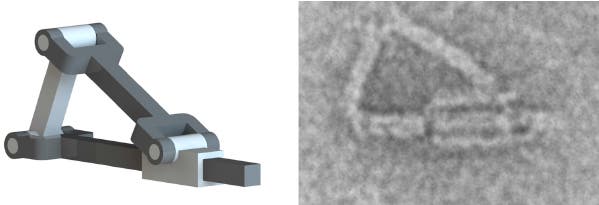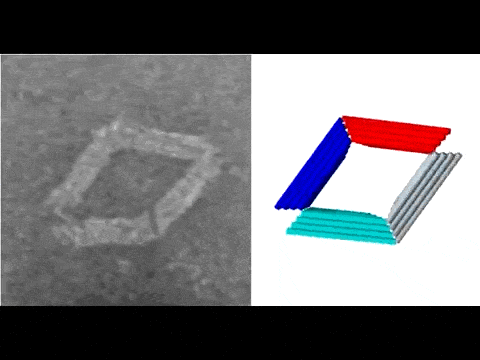For the very first time, engineers have used the DNA origami assembly method to build complex DNA-based mechanism that performs a repeatable and reversible function. Mechanical engineers at The Ohio State University built their devices such that they may function like any regular macro-object, like opening and closing hinges. Their approach, however, is different than other DNA assembly projects which concentrated on mimicking biological systems or static shapes. Such dynamic molecule-sized devices could be used in smart drug delivery or self-assembling tiny transformers-like robots.
DNA origami hinges
The DNA origami method for making nano-structures has been widely used since 2006, and is now a standard procedure for many labs that are developing future drug delivery systems and electronics. It involves taking long strands of DNA and coaxing them to fold into different shapes, then securing certain parts together with “staples” made from shorter DNA strands. The resulting structure is stable enough to perform a basic task, such as carrying a small amount of medicine inside a container-like DNA structure and opening the container to release it.
[RELATED] Nanorobots made out of DNA seek and kill cancer cells
“Nature has produced incredibly complex molecular machines at the nanoscale, and a major goal of bio-nanotechnology is to reproduce their function synthetically,” saidCarlos Castro, the group project leader and an assistant professor of mechanical and aerospace engineering. “In essence, we are using a bio-molecular system to mimic large-scale engineering systems to achieve the same goal of developing molecular machines.”

To get their DNA machines to function properly, the engineers designed the flexing parts out of single-stranded DNA, while those regions that were supposed to be stiff were built from snips of double-stranded DNA. In the case of hinges that repeatedly open and close, this also had to perform their operation reversibly, so the engineers attached small strands of synthetic DNA off the side of the main components. Like a hook-and-loop fastener, the strands latch onto each other when the device is closed and release when opened. To control the operations of the machine, researchers make changes to the chemical environment. The machines then respond to this stimuli accordingly.
“DNA origami enables the precise fabrication of nanoscale geometries,” the authors write. “We demonstrate an approach to engineer complex and reversible motion of nanoscale DNA origami machine elements…Our results demonstrate programmable motion of 2-D and 3-D DNA origami mechanisms constructed following a macroscopic machine design approach.”
This approach of designing simple joints and connecting them together to make more complex working systems is common in macroscopic machine design, but this is the first time it’s been done with DNA—and the first time anyone has tuned the DNA to produce reversible actuation of a complex mechanism, as described in a paper published in Proceedings of the National Academy of Sciences.
“I’m pretty excited by this idea,” Castro said. “I do think we can ultimately build something like a Transformer system, though maybe not quite like in the movies. I think of it more as a nano-machine that can detect signals such as the binding of a biomolecule, process information based on those signals, and then respond accordingly—maybe by generating a force or changing shape.”








